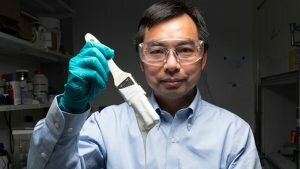One might not expect that ordinary pigments could be used to make a tremendous impact in the areas of environmental sustainability, but scientists have been pioneering new ways to make going green more colorful than ever. Just this year, two amazing inventions were developed by researchers in Indiana that could represent game-changing developments for our eco-friendly future.
World’s Whitest Paint
 Purdue University Professor of Mechanical Engineering Xiulin Ruan holds up his lab’s sample of the whitest paint on record. (Image from Purdue University, John Underwood.)[/caption]
Purdue University Professor of Mechanical Engineering Xiulin Ruan holds up his lab’s sample of the whitest paint on record. (Image from Purdue University, John Underwood.)[/caption] It might sound crazy, but a new type of paint recently invented by Purdue University researchers has been recognized among “most exciting creative developments in the connected world.” It’s officially the world’s whitest paint, as noted by Guinness World Records, and it recently won an Innovation Award in sustainability from the South by Southwest Conference & Festivals (SXSW).
Why is the world’s whitest paint important for environmental efforts, you ask? It might be revolutionary for keeping buildings cool in high heat.
The paint was developed Professor of Mechanical Engineering Xiulin Ruan to help fight global warming by keeping surfaces cool enough to reduce the need for internal air conditioning. The paint is ideal for radiating heat away from cars, trains, airplanes, and even spacecraft.
Typical commercial white paint gets warmer rather than cooler when subjected to sunlight or other light sources. Paints on the market that are designed to reject heat reflect only 80% to 90% of sunlight and can’t make surfaces cooler than their surroundings. In comparison, the world’s whitest paint reflects 98.1% of solar heat away from its surface.
Because the paint absorbs less heat from the sun than it emits, a surface coated with this paint is cooled below the surrounding temperature without consuming power. Using this formulation to cover a roof area of about 1,000 square feet could result in a cooling power of 10 kilowatts, more powerful than the air conditioners used by most houses.
Another awesome feature of this paint is that it’s projected to be affordable. Professor Ruan says the cost and production process of the world’s whitest paint is expected to be similar to commercial paint.
Purifying Water with the Sun
 László Forró, Aurora and Thomas Marquez Professor of Physics of Complex Quantum Matter in the University of Notre Dame's Department of Physics and Astronomy. (Image from Notre Dame.)
László Forró, Aurora and Thomas Marquez Professor of Physics of Complex Quantum Matter in the University of Notre Dame's Department of Physics and Astronomy. (Image from Notre Dame.)Water contamination, especially in rural areas or in developing countries, is a huge health hazard around the world. Most modern water purification systems rely on electricity or sanitation networks, which may not be available in areas that lack the necessary infrastructure to support them. But one resource that is available all over the planet is sunlight, which researchers at the University of Notre Dame are using with a new invention to produce clean drinking water.
László Forró is the Aurora and Thomas Marquez Professor of Physics of Complex Quantum Matter in the University of Notre Dame's Department of Physics and Astronomy. His lab has developed a water purifier that uses titanium dioxide, a readily available material known for its light scattering properties. This substance is a pigment commonly found in toothpastes and sunscreens that most folks might recognize as the “titanium white” color.
Titanium dioxide can react to light in by producing highly reactive forms of oxygen called “free radicals.” These free radicals are capable of destroying the parasites, bacteria, and viruses found in contaminated water.
Developing a prototype wasn’t easy because the scientists had to develop a new process to produce enough titanium dioxide mesh to form a filtration system. But once they started conducting tests, the results were very exciting.
The researchers started with water from a nearby river and found their device was capable of completely eradicating any E. coli from the water. They also tested the device on water mixed with a “cocktail” of nine different pollutants. These included drug residues, pesticides, maintenance products, hormones, and cosmetics. They found that the filter's three-part sanitation process removed significant portions of even these pollutive molecules from water.
Work is still ongoing to improve the process, but the device can already sanitize two liters of water a day, enough for one person’s drinking water. Forró’s team says larger applications in the future will add even greater benefits.
Painting a Bright Future
These two incredible pigment innovations from Indiana represent exciting new developments in the field of environmental sustainability. The world's whitest paint has the potential to revolutionize the cooling of buildings and transportation, reducing the need for internal air conditioning and consuming less power. The second invention, a water purifier using titanium dioxide, is potentially lifesaving solution in areas without reliable access to electricity or sanitation. Indiana scientists have been up to some very cool things lately, and it’ll be exciting to watch as they continue to paint a bright future for our world.